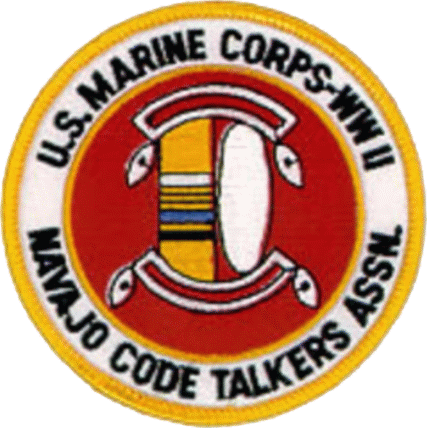

This episode of the Marine Time Machine is about the Navajo Code Talkers. As we observe Navajo Code Talkers Day, we remember these American heroes who created the only military code to never have been deciphered.
During times of war, secure communications can mean the difference between life and death; victory and defeat. In World War I and World War II, the United States military relied on a unique series of codes to keep its messages safe from the enemy. These codes weren’t based on cutting-edge technology or complex mathematical equations, though. Finding their origins in Native American languages, these codes were spoken by a brave group of men recruited from tribal communities across the country. Those men became known as Code Talkers.
With both Veterans Day and Native American Heritage Month in November, now is a great time to tell the stories of these heroes.

In World War I, soldiers of Native American descent, mostly Choctaw, used their tribal languages to transmit messages by telephone. Though not used extensively, the actions of these men confused the Germans and helped win several battles in France.
When the United States entered World War II, the military again called on Native Americans to be Code Talkers. Fearing that some of the previously used languages may have been studied by the Germans and Japanese between the wars, military leaders looked for a new code that was more complex. For the U.S. Marine Corps, the Navajo language quickly became the answer. It isn’t a written language and very few people not of Navajo origin understood it.

In 1942, the Marine Corps began recruiting and training Navajo men to be Code Talkers. Carl Gorman was one of the first Navajo to join up. “For us, everything is memory, it’s part of our heritage. We have no written language. Our songs, our prayers, our stories, they’re all handed down from grandfather to father to children — and we listen, we hear, we learn to remember everything. It’s part of our training.”
The first 29 Navajo Code Talkers created an phonic alphabet and used word substitution to develop an all but unbreakable code. “Fighter plane” became “hummingbird.” “Turtle” became “tank.” “”Battleship” became “whale.”
Other branches of the military recruited Native Americans from the Assiniboine, Cherokee, Cheyenne, Chippewa, Choctaw, Comanche, Cree, Crow, Hopi, Kiowa, Menominee, Meskwaki, Mississauga, Muscogee, Osage, Pawnee, Sac and Fox, Seminole and Sioux tribes to create similar military codes based on their own languages.

After the codes were established, trained Code Talkers joined combat units around the world. The Navajo and Hopi were assigned to service in the Pacific. Comanches fought the Germans in Europe, and the Meskwakis fought them in North Africa. Code Talkers from other tribes fought at various locations in Europe, the Pacific, North Africa and elsewhere. Because the code was considered to be so important, many Code Talkers were assigned guards and weren’t allowed to move around alone.
Fighting in the battles of Guadalcanal, Tarawa, Tinian, Saipan and the D-Day invasion of Normandy, Code Talkers saved lives by signaling enemy movements, transmitting orders and coordinating attacks under fire. Major Howard Cooper, a signal officer commanding Code Talkers, said “Were it not for the Navajos, the Marines would never have taken Iwo Jima.”
The Code Talkers were proud of their accomplishments in combat and communications. Navajo Thomas Begay would later say about the codes, “It means a lot to me. Nobody — Japanese, no one — ever decoded it.”

Despite earning the respect of their fellow soldiers and marines, Code Talkers received no recognition on the home front. Their code and actions remained classified until 1968. As their role in the war became better known, Code Talkers have been celebrated in movies and television shows, and many have been awarded medals from Presidents and Congress.
Combining the wisdom and warrior tradition of their tribes with modern day technology and tactics, Code Talkers earned their place as American heroes.
Source: Department Of The Interior
more recommended stories
 Fentanyl Seizures at Border Continue to Spike, Making San Diego a National Epicenter for Fentanyl Trafficking
Fentanyl Seizures at Border Continue to Spike, Making San Diego a National Epicenter for Fentanyl TraffickingFentanyl Seizures at Border Continue to.
 Utah Man Sentenced for Hate Crime Attack of Three Men
Utah Man Sentenced for Hate Crime Attack of Three MenTuesday, August 8, 2023 A.
 Green Energy Company Biden Hosted At White House Files For Bankruptcy
Green Energy Company Biden Hosted At White House Files For BankruptcyAug 7 (Reuters) – Electric-vehicle parts.
 Former ABC News Reporter Who “Debunked” Pizzagate Pleads Guilty of Possessing Child pδrn
Former ABC News Reporter Who “Debunked” Pizzagate Pleads Guilty of Possessing Child pδrnFriday, July 21, 2023 A former.
 Six Harvard Medical School and an Arkansas mortuary Charged With Trafficking In Stolen Human Remains
Six Harvard Medical School and an Arkansas mortuary Charged With Trafficking In Stolen Human RemainsSCRANTON – The United States.
 Over 300 People Facing Federal Charges For Crimes Committed During Nationwide Demonstrations
Over 300 People Facing Federal Charges For Crimes Committed During Nationwide DemonstrationsThe Department of Justice announced that.
